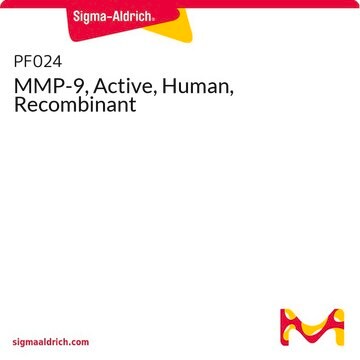M9570
Anti-Matrix Metalloproteinase-9 antibody produced in goat
affinity isolated antibody
Synonim(y):
MMP-9 Antibody - Anti-Matrix Metalloproteinase-9 antibody produced in goat, Mmp-9 Antibody, Anti-MMP-9
About This Item
Polecane produkty
pochodzenie biologiczne
goat
Poziom jakości
białko sprzężone
unconjugated
forma przeciwciała
affinity isolated antibody
rodzaj przeciwciała
primary antibodies
klon
polyclonal
reaktywność gatunkowa
mouse
metody
immunohistochemistry: 5-15 μg/mL using cells or tissues
immunoprecipitation (IP): 25 μg/mL using conditioned media of transfected NSO cells
western blot: 0.25 μg/mL
numer dostępu UniProt
temp. przechowywania
−20°C
docelowa modyfikacja potranslacyjna
unmodified
informacje o genach
mouse ... Mmp9(17395)
Powiązane kategorie
Opis ogólny
Specyficzność
Immunogen
Zastosowanie
Immunohistochemistry (1 paper)
Western Blotting (1 paper)
Działania biochem./fizjol.
Opis wartości docelowych
Postać fizyczna
Oświadczenie o zrzeczeniu się odpowiedzialności
Not finding the right product?
Try our Narzędzie selektora produktów.
Kod klasy składowania
11 - Combustible Solids
Klasa zagrożenia wodnego (WGK)
WGK 1
Temperatura zapłonu (°F)
Not applicable
Temperatura zapłonu (°C)
Not applicable
Środki ochrony indywidualnej
Eyeshields, Gloves, type N95 (US)
Certyfikaty analizy (CoA)
Poszukaj Certyfikaty analizy (CoA), wpisując numer partii/serii produktów. Numery serii i partii można znaleźć na etykiecie produktu po słowach „seria” lub „partia”.
Masz już ten produkt?
Dokumenty związane z niedawno zakupionymi produktami zostały zamieszczone w Bibliotece dokumentów.
Nasz zespół naukowców ma doświadczenie we wszystkich obszarach badań, w tym w naukach przyrodniczych, materiałoznawstwie, syntezie chemicznej, chromatografii, analityce i wielu innych dziedzinach.
Skontaktuj się z zespołem ds. pomocy technicznej








